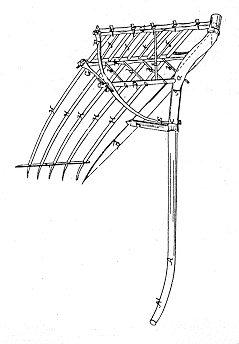
Cradle (grain)
Encyclopedia
A cradle is an agricultural
tool, a form of the scythe
, used to reap grain. It is a scythe with an arrangement of fingers attached to the snath, snathe or snaith (handle), such that the cut grain falls upon the fingers and can be cleanly laid down in a row for collection.
was the usual tool, leaving sheaves of grain to be gathered. The scythe improved the process, because the long handle allows the reaper to work standing up.
Reaping with a scythe before the invention of the cradle readily resulted in the grain forming a muddled carpet on the field, making gathering and transport time-consuming.
In 1794, a Scottish farmer invented "a most marvellous and wonderful machine for cutting grain" . This was the cradle, which revolutionized the harvesting of grains.
 The American-pattern cradle probably originated between 1800–1840.
The American-pattern cradle probably originated between 1800–1840.
Users of this tool could harvest significantly increased amounts of grain on a daily basis.
The center of interest in this agricultural tool was the American Midwest, where grain growing was a major industry. United States
patent
s in the decades from 1820 to 1930 totaled 50, the first issued in 1823 to a gentleman in western New York state and the last issued in 1924 to a gentleman in West Virginia. The peak of innovation was in the third quarter of the 19th century .
, a horse-drawn (or tractor-drawn) machine patented by Cyrus McCormick
in 1834, and later by other mechanical methods of harvesting such as the combine harvester
.
Agriculture
Agriculture is the cultivation of animals, plants, fungi and other life forms for food, fiber, and other products used to sustain life. Agriculture was the key implement in the rise of sedentary human civilization, whereby farming of domesticated species created food surpluses that nurtured the...
tool, a form of the scythe
Scythe
A scythe is an agricultural hand tool for mowing grass, or reaping crops. It was largely replaced by horse-drawn and then tractor machinery, but is still used in some areas of Europe and Asia. The Grim Reaper is often depicted carrying or wielding a scythe...
, used to reap grain. It is a scythe with an arrangement of fingers attached to the snath, snathe or snaith (handle), such that the cut grain falls upon the fingers and can be cleanly laid down in a row for collection.
History
As agriculture (and particularly the cultivation of grain) developed, the end of a season was the harvest. Grain could be pulled or, more typically, cut and the sickleSickle
A sickle is a hand-held agricultural tool with a variously curved blade typically used for harvesting grain crops or cutting succulent forage chiefly for feeding livestock . Sickles have also been used as weapons, either in their original form or in various derivations.The diversity of sickles that...
was the usual tool, leaving sheaves of grain to be gathered. The scythe improved the process, because the long handle allows the reaper to work standing up.
Reaping with a scythe before the invention of the cradle readily resulted in the grain forming a muddled carpet on the field, making gathering and transport time-consuming.
In 1794, a Scottish farmer invented "a most marvellous and wonderful machine for cutting grain" . This was the cradle, which revolutionized the harvesting of grains.
The American cradle

Users of this tool could harvest significantly increased amounts of grain on a daily basis.
The center of interest in this agricultural tool was the American Midwest, where grain growing was a major industry. United States
United States
The United States of America is a federal constitutional republic comprising fifty states and a federal district...
patent
Patent
A patent is a form of intellectual property. It consists of a set of exclusive rights granted by a sovereign state to an inventor or their assignee for a limited period of time in exchange for the public disclosure of an invention....
s in the decades from 1820 to 1930 totaled 50, the first issued in 1823 to a gentleman in western New York state and the last issued in 1924 to a gentleman in West Virginia. The peak of innovation was in the third quarter of the 19th century .
Decline
The cradle was commonly used throughout the 1800s and into the beginning of the 20th century, in part because many of the smaller farms were not designed for mechanical reaping and in part because there were still a great number of smaller farms where the mechanical reaper was not economical. However, by the end of the 19th century the cradle had been generally replaced by the mechanical reaperReaper
A reaper is a person or machine that reaps crops at harvest, when they are ripe.-Hand reaping:Hand reaping is done by various means, including plucking the ears of grains directly by hand, cutting the grain stalks with a sickle, cutting them with a scythe, or with a later type of scythe called a...
, a horse-drawn (or tractor-drawn) machine patented by Cyrus McCormick
Cyrus McCormick
Cyrus Hall McCormick, Sr. was an American inventor and founder of the McCormick Harvesting Machine Company, which became part of International Harvester Company in 1902.He and many members of the McCormick family became prominent Chicagoans....
in 1834, and later by other mechanical methods of harvesting such as the combine harvester
Combine harvester
The combine harvester, or simply combine, is a machine that harvests grain crops. The name derives from the fact that it combines three separate operations, reaping, threshing, and winnowing, into a single process. Among the crops harvested with a combine are wheat, oats, rye, barley, corn ,...
.

